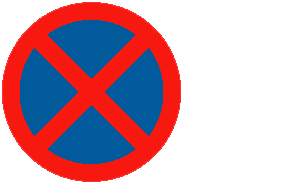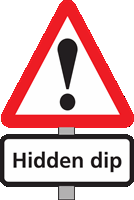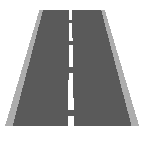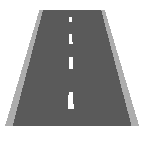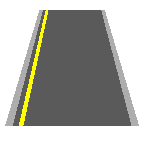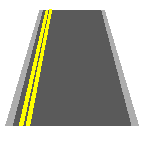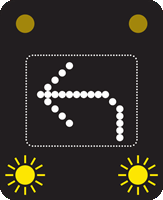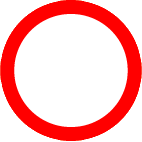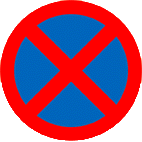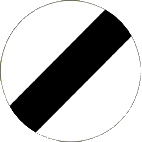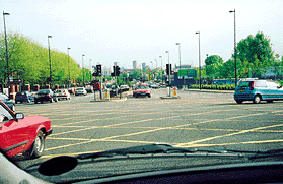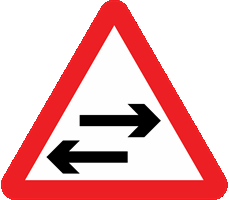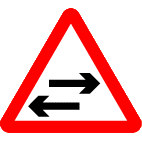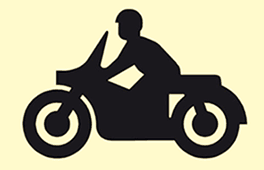You have 57 minutes to answer 50 multiple choice theory test questions. You need to answer at least 43 out of 50 questions correctly to pass. You can review your answer after each question or you can review all of your answers at the end of the test. Best of luck!
Test Quick View
Click on an answer to view the correct choice along with the explanation.
Correct Answer: D
Explanation: Vehicles can be noisy. Every effort must be made to prevent excessive noise, especially in built-up areas at night. Don't
- rev the engine,
- sound the horn unnecessarily. It is illegal to sound your horn in a built-up area between 11.30 pm and 7 am, except when another vehicle poses a danger.
Explanation: Vehicles can be noisy. Every effort must be made to prevent excessive noise, especially in built-up areas at night. Don't
- rev the engine,
- sound the horn unnecessarily. It is illegal to sound your horn in a built-up area between 11.30 pm and 7 am, except when another vehicle poses a danger.
2. Supertrams or Light Rapid Transit (LRT) systems are environmentally friendly because
Mark one answer
B
C
D
Correct Answer: C
Explanation: This means that they do not emit toxic fumes, which add to city pollution problems. They are also a lot quieter and smoother to ride on.
Explanation: This means that they do not emit toxic fumes, which add to city pollution problems. They are also a lot quieter and smoother to ride on.
Correct Answer: C
Explanation: Look well ahead to see if any hazards are developing. This will give you more time to deal with them in the correct way. The man in the picture is clearly intending to cross the road. You should be travelling at a speed that allows you to check your mirror, slow down and stop in good time. You shouldn't have to brake harshly.
Explanation: Look well ahead to see if any hazards are developing. This will give you more time to deal with them in the correct way. The man in the picture is clearly intending to cross the road. You should be travelling at a speed that allows you to check your mirror, slow down and stop in good time. You shouldn't have to brake harshly.
Correct Answer: A, B
Explanation: Don't pass riders too closely as this may cause them to lose balance. Always leave as much room as you would for a car, and don't cut in.
Explanation: Don't pass riders too closely as this may cause them to lose balance. Always leave as much room as you would for a car, and don't cut in.

B
C
D
Correct Answer: C
Explanation: When a long vehicle is going to turn right it may need to keep close to the left-hand kerb. This is to prevent the rear end of the trailer cutting the corner. You need to be aware of how long vehicles behave in such situations. Don't overtake the lorry because it could turn as you're alongside. Stay behind and wait for it to turn.
Explanation: When a long vehicle is going to turn right it may need to keep close to the left-hand kerb. This is to prevent the rear end of the trailer cutting the corner. You need to be aware of how long vehicles behave in such situations. Don't overtake the lorry because it could turn as you're alongside. Stay behind and wait for it to turn.
Correct Answer: A
Explanation: Clearways are in place so that traffic can flow without the obstruction of parked vehicles. Just one parked vehicle will cause an obstruction for all other traffic. You MUST NOT stop where a clearway is in force, not even to pick up or set down passengers.
Explanation: Clearways are in place so that traffic can flow without the obstruction of parked vehicles. Just one parked vehicle will cause an obstruction for all other traffic. You MUST NOT stop where a clearway is in force, not even to pick up or set down passengers.
Correct Answer: C
Explanation: A sign will indicate which types of vehicles are prohibited from certain roads. Make sure that you know which signs apply to the vehicle you're using.
Explanation: A sign will indicate which types of vehicles are prohibited from certain roads. Make sure that you know which signs apply to the vehicle you're using.
Correct Answer: C
Explanation: This sign is in place to ensure a clear route for traffic. Don't stop except in an emergency.
Explanation: This sign is in place to ensure a clear route for traffic. Don't stop except in an emergency.
Correct Answer: A
Explanation: You won't be able to see any hazards that might be hidden in the dip. As well as oncoming traffic the dip may conceal
- cyclists,
- horse riders,
- parked vehicles,
- pedestrians in the road.
Explanation: You won't be able to see any hazards that might be hidden in the dip. As well as oncoming traffic the dip may conceal
- cyclists,
- horse riders,
- parked vehicles,
- pedestrians in the road.
Correct Answer: A
Explanation: You need to know the difference between the normal centre line and a hazard warning line. If there is a hazard ahead, the markings are longer and the gaps shorter. This gives you advanced warning of an unspecified hazard ahead.
Explanation: You need to know the difference between the normal centre line and a hazard warning line. If there is a hazard ahead, the markings are longer and the gaps shorter. This gives you advanced warning of an unspecified hazard ahead.
Correct Answer: B
Explanation: You'll see this sign if the motorway is closed ahead. Pull into the nearside lane as soon as it is safe to do so. Don't leave it to the last moment.
Explanation: You'll see this sign if the motorway is closed ahead. Pull into the nearside lane as soon as it is safe to do so. Don't leave it to the last moment.
Correct Answer: D
Explanation: You should know the speed limit for the road on which you are travelling, and the vehicle that you are driving. The different speed limits are shown in The Highway Code.
Explanation: You should know the speed limit for the road on which you are travelling, and the vehicle that you are driving. The different speed limits are shown in The Highway Code.
13. There are flashing amber lights under a school warning sign. What action should you take?
Mark one answer
B
C
D
Correct Answer: C
Explanation: The flashing amber lights are switched on to warn you that children may be crossing near a school. Slow down and take extra care as you may have to stop.
Explanation: The flashing amber lights are switched on to warn you that children may be crossing near a school. Slow down and take extra care as you may have to stop.
Correct Answer: A
Explanation: The markings are there to show that the area must be kept clear to allow an unrestricted view for
- approaching drivers and riders,
- children wanting to cross the road.
Explanation: The markings are there to show that the area must be kept clear to allow an unrestricted view for
- approaching drivers and riders,
- children wanting to cross the road.
Correct Answer: C
Explanation: On a three-lane motorway you should travel in the left-hand lane unless you're overtaking. This applies regardless of the speed at which you're travelling.
Explanation: On a three-lane motorway you should travel in the left-hand lane unless you're overtaking. This applies regardless of the speed at which you're travelling.
B
C
D
Correct Answer: B
Explanation: It's important to keep a safe distance from the vehicle in front at all times. This still applies in congested tunnels even if you are moving very slowly or have stopped. If the vehicle in front breaks down you may need room to manoeuvre past it.
Explanation: It's important to keep a safe distance from the vehicle in front at all times. This still applies in congested tunnels even if you are moving very slowly or have stopped. If the vehicle in front breaks down you may need room to manoeuvre past it.
Correct Answer: B
Explanation: Collisions can often happen at roadworks. Be aware of the speed limits, slow down in good time and keep your distance from the vehicle in front.
Explanation: Collisions can often happen at roadworks. Be aware of the speed limits, slow down in good time and keep your distance from the vehicle in front.
Correct Answer: C
Explanation: You MUST NOT enter a box junction until your exit road or lane is clear. The exception to this is if you want to turn right and are only prevented from doing so by oncoming traffic or by other vehicles waiting to turn right.
Explanation: You MUST NOT enter a box junction until your exit road or lane is clear. The exception to this is if you want to turn right and are only prevented from doing so by oncoming traffic or by other vehicles waiting to turn right.
Correct Answer: A
Explanation: Be prepared for traffic approaching from junctions on either side of you. Try to avoid unnecessary changing of lanes just before the junction.
Explanation: Be prepared for traffic approaching from junctions on either side of you. Try to avoid unnecessary changing of lanes just before the junction.
Correct Answer: D
Explanation: By making a SORN, DVLA will know that this vehicle is being kept off the public road and does not need vehicle excise duty to be paid. Once you have made a SORN, it remains valid until you tax, sell or scrap the vehicle.
Explanation: By making a SORN, DVLA will know that this vehicle is being kept off the public road and does not need vehicle excise duty to be paid. Once you have made a SORN, it remains valid until you tax, sell or scrap the vehicle.
Correct Answer: A
Explanation: If there is a bend just before the level crossing you may not be able to see the level crossing barriers or waiting traffic. These signs give you an early warning that you may find these hazards just around the bend.
Explanation: If there is a bend just before the level crossing you may not be able to see the level crossing barriers or waiting traffic. These signs give you an early warning that you may find these hazards just around the bend.
22. After a collision someone has suffered a burn. The burn needs to be cooled. What is the shortest time it should be cooled for?
Mark one answer
B
C
D
Correct Answer: A
Explanation: It's important to cool a burn for at least ten minutes. Use a clean, cold non-toxic liquid preferably water. Bear in mind the person may also be in shock.
Explanation: It's important to cool a burn for at least ten minutes. Use a clean, cold non-toxic liquid preferably water. Bear in mind the person may also be in shock.
23. Overtaking is a major cause of collisions. In which THREE of these situations should you NOT overtake?
Mark three answers
B
C
D
E
Correct Answer: B, C, E
Explanation: You should not overtake unless it is really necessary. Arriving safely is more important than taking risks. Also look out for road signs and markings that show it is illegal or would be unsafe to overtake. In many cases overtaking is unlikely to significantly improve journey times.
Explanation: You should not overtake unless it is really necessary. Arriving safely is more important than taking risks. Also look out for road signs and markings that show it is illegal or would be unsafe to overtake. In many cases overtaking is unlikely to significantly improve journey times.
Correct Answer: B
Explanation: This sign is found in or at the end of a one-way system. It warns you that traffic will be crossing your path from both directions.
Explanation: This sign is found in or at the end of a one-way system. It warns you that traffic will be crossing your path from both directions.
25. You are on a good, dry, road surface. Your brakes and tyres are good. What is the typical overall stopping distance at 40 mph?
Mark one answer
B
C
D
Correct Answer: B
Explanation: Stopping distances are affected by a number of variable factors. These include the type, model and condition of your vehicle, road and weather conditions, and your reaction time. Look well ahead for hazards and leave enough space between you and the vehicle in front. This should allow you to pull up safely if you have to, without braking sharply.
Explanation: Stopping distances are affected by a number of variable factors. These include the type, model and condition of your vehicle, road and weather conditions, and your reaction time. Look well ahead for hazards and leave enough space between you and the vehicle in front. This should allow you to pull up safely if you have to, without braking sharply.
26. At an incident a casualty is unconscious but still breathing. You should only move them if
Mark one answer
B
C
D
Correct Answer: D
Explanation: Do not move a casualty unless there is further danger, for example, from other traffic or fire. They may have unseen or internal injuries. Moving them unnecessarily could cause further injury. Do NOT remove a motorcyclists helmet unless it's essential.
Explanation: Do not move a casualty unless there is further danger, for example, from other traffic or fire. They may have unseen or internal injuries. Moving them unnecessarily could cause further injury. Do NOT remove a motorcyclists helmet unless it's essential.
27. A collision has just happened. An injured person is lying in a busy road. What is the FIRST thing you should do to help?
Mark one answer
B
C
D
Correct Answer: D
Explanation: The most immediate danger is further collisions and fire. You could warn other traffic by displaying an advance warning triangle or sign (but not on a motorway), switching on hazard warning lights or by any other means that does not put you or others at risk.
Explanation: The most immediate danger is further collisions and fire. You could warn other traffic by displaying an advance warning triangle or sign (but not on a motorway), switching on hazard warning lights or by any other means that does not put you or others at risk.
Correct Answer: A, D
Explanation: Ensure that you can see clearly through the windscreen of your vehicle. Stickers or hanging objects could affect your field of vision or draw your eyes away from the road
Explanation: Ensure that you can see clearly through the windscreen of your vehicle. Stickers or hanging objects could affect your field of vision or draw your eyes away from the road
29. You are about to drive home. You feel very tired and have a severe headache. You should
Mark one answer
B
C
D
Correct Answer: D
Explanation: All your concentration should be on your driving. Any pain you feel will distract you and you should avoid driving when drowsy. The safest course of action is to wait until you have rested and feel better.
Explanation: All your concentration should be on your driving. Any pain you feel will distract you and you should avoid driving when drowsy. The safest course of action is to wait until you have rested and feel better.
30. You want to reverse into a side road. You are not sure that the area behind your car is clear. What should you do?
Mark one answer
B
C
D
Correct Answer: C
Explanation: If you cannot be sure whether there is anything behind you, it is always safest to check before reversing. There may be a small child or a low obstruction close behind your car. The shape and size of your vehicle can restrict visibility.
Explanation: If you cannot be sure whether there is anything behind you, it is always safest to check before reversing. There may be a small child or a low obstruction close behind your car. The shape and size of your vehicle can restrict visibility.
B
C
D
Correct Answer: B
Explanation: There could be a motorcyclist riding along the outside of the queue. Always check your mirror before turning as situations behind you can change in the time you have been waiting to turn.
Explanation: There could be a motorcyclist riding along the outside of the queue. Always check your mirror before turning as situations behind you can change in the time you have been waiting to turn.
32. Hills can affect the performance of your vehicle. Which TWO apply when driving up steep hills?
Mark two answers
B
C
D
E
Correct Answer: C, E
Explanation: The engine will need more power to pull the vehicle up the hill. When approaching a steep hill you should select a lower gear to help maintain your speed. You should do this without hesitation, so that you don't lose too much speed before engaging the lower gear.
Explanation: The engine will need more power to pull the vehicle up the hill. When approaching a steep hill you should select a lower gear to help maintain your speed. You should do this without hesitation, so that you don't lose too much speed before engaging the lower gear.
33. You are driving along a road that has a cycle lane. The lane is marked by a solid white line. This means that during its period of operation
Mark one answer
B
C
D
Correct Answer: D
Explanation: Leave the lane free for cyclists. At other times, when the lane is not in operation, you should still be aware that there may be cyclists about. Give them room and don't pass too closely.
Explanation: Leave the lane free for cyclists. At other times, when the lane is not in operation, you should still be aware that there may be cyclists about. Give them room and don't pass too closely.
34. You go to a social event and need to drive a short time after. What precaution should you take?
Mark one answer
B
C
D
Correct Answer: A
Explanation: This is always going to be the safest option. Just one drink could put you over the limit and dangerously impair your judgement and reactions.
Explanation: This is always going to be the safest option. Just one drink could put you over the limit and dangerously impair your judgement and reactions.
35. You are driving with your front fog lights switched on. Earlier fog has now cleared. What should you do?
Mark one answer
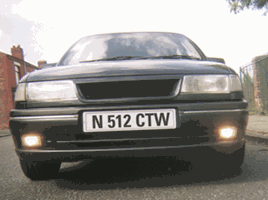
B
C
D
Correct Answer: D
Explanation: Switch off your fog lights if the weather improves, but be prepared to use them again if visibility reduces to less than 100 metres (328 feet).
Explanation: Switch off your fog lights if the weather improves, but be prepared to use them again if visibility reduces to less than 100 metres (328 feet).
Correct Answer: D
Explanation: As well as being at least 21 years old you must hold a full EC/EEA driving licence for the category of vehicle being driven and have held that licence for at least three years.
Explanation: As well as being at least 21 years old you must hold a full EC/EEA driving licence for the category of vehicle being driven and have held that licence for at least three years.
Correct Answer: C
Explanation: If you can see valuables in your car so can a thief. If you can't take them with you lock them out of sight or you risk losing them, as well as having your car damaged.
Explanation: If you can see valuables in your car so can a thief. If you can't take them with you lock them out of sight or you risk losing them, as well as having your car damaged.
38. Why could keeping the clutch down or selecting neutral for long periods of time be dangerous?
Mark one answer
B
C
D
Correct Answer: D
Explanation: Letting your vehicle roll or coast in neutral reduces your control over steering and braking. This can be dangerous on downhill slopes where your vehicle could pick up speed very quickly.
Explanation: Letting your vehicle roll or coast in neutral reduces your control over steering and braking. This can be dangerous on downhill slopes where your vehicle could pick up speed very quickly.
39. You are towing a caravan along a motorway. The caravan begins to swerve from side to side. What should you do?
Mark one answer

B
C
D
Correct Answer: B
Explanation: Try not to brake or steer heavily as this will only make matters worse and you could lose control altogether. Keep calm and regain control by easing off the accelerator.
Explanation: Try not to brake or steer heavily as this will only make matters worse and you could lose control altogether. Keep calm and regain control by easing off the accelerator.
Correct Answer: A, B, E
Explanation: Third party insurance doesn't cover damage to your own vehicle or injury to yourself. If you have a crash and your vehicle is damaged you might have to carry out the repairs at your own expense.
Explanation: Third party insurance doesn't cover damage to your own vehicle or injury to yourself. If you have a crash and your vehicle is damaged you might have to carry out the repairs at your own expense.
Correct Answer: B
Explanation: Emission tests are carried out to ensure your vehicle's engine is operating efficiently. This ensures the pollution produced by the engine is kept to a minimum. If your vehicle is not serviced regularly, it may fail the annual MOT test.
Explanation: Emission tests are carried out to ensure your vehicle's engine is operating efficiently. This ensures the pollution produced by the engine is kept to a minimum. If your vehicle is not serviced regularly, it may fail the annual MOT test.
Correct Answer: A
Explanation: Always look out for motorcyclists, and cyclists, particularly at junctions. They are smaller and usually more difficult to see than other vehicles.
Explanation: Always look out for motorcyclists, and cyclists, particularly at junctions. They are smaller and usually more difficult to see than other vehicles.
43. Where should you take particular care to look out for motorcyclists and cyclists?
Mark one answer
B
C
D
Correct Answer: A
Explanation: Motorcyclists and cyclists are often more difficult to see on the road. This is especially the case at junctions. You may not be able to see a motorcyclist approaching a junction if your view is blocked by other traffic. A motorcycle may be travelling as fast as a car, sometimes faster. Make sure that you judge speeds correctly before you emerge.
Explanation: Motorcyclists and cyclists are often more difficult to see on the road. This is especially the case at junctions. You may not be able to see a motorcyclist approaching a junction if your view is blocked by other traffic. A motorcycle may be travelling as fast as a car, sometimes faster. Make sure that you judge speeds correctly before you emerge.
Correct Answer: B
Explanation: Whenever possible leave your car in a secure car park. This will help stop thieves.
Explanation: Whenever possible leave your car in a secure car park. This will help stop thieves.
Correct Answer: B
Explanation: If you are wearing sunglasses you should remove them before driving into a tunnel. If you don't, your vision will be restricted, even in tunnels that appear to be well-lit.
Explanation: If you are wearing sunglasses you should remove them before driving into a tunnel. If you don't, your vision will be restricted, even in tunnels that appear to be well-lit.
46. Your car is fitted with anti-lock brakes. You need to stop in an emergency. You should
Mark one answer
B
C
D
Correct Answer: D
Explanation: Keep pressure on the brake pedal until you have come to a stop. The anti-lock mechanism will activate automatically if it senses the wheels are about to lock.
Explanation: Keep pressure on the brake pedal until you have come to a stop. The anti-lock mechanism will activate automatically if it senses the wheels are about to lock.
47. You are driving towards this left-hand bend. What dangers should you be aware of?
Mark one answer
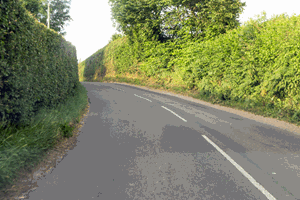
B
C
D
Correct Answer: D
Explanation: Pedestrians walking on a road with no pavement should walk against the direction of the traffic. You can't see around this bend: there may be hidden dangers. Always keep this in mind so you give yourself time to react if a hazard does arise.
Explanation: Pedestrians walking on a road with no pavement should walk against the direction of the traffic. You can't see around this bend: there may be hidden dangers. Always keep this in mind so you give yourself time to react if a hazard does arise.
Correct Answer: B, D
Explanation: This type of insurance cover is usually cheaper than comprehensive. However, it does not cover any damage to your own vehicle or property. It only covers damage and injury to others.
Explanation: This type of insurance cover is usually cheaper than comprehensive. However, it does not cover any damage to your own vehicle or property. It only covers damage and injury to others.
49. Car passengers MUST wear a seat belt/restraint if one is available, unless they are
Mark one answer
B
C
D
Correct Answer: A
Explanation: If you have adult passengers it is their responsibility to wear a seat belt, but you should still remind them to use them as they get in the car. It is your responsibility to ensure that all children in your car are secured with an appropriate restraint.
Explanation: If you have adult passengers it is their responsibility to wear a seat belt, but you should still remind them to use them as they get in the car. It is your responsibility to ensure that all children in your car are secured with an appropriate restraint.
50. You have a collision while driving through a tunnel. You are not injured but your vehicle cannot be driven. What should you do FIRST?
Mark one answer
B
C
D
Correct Answer: C
Explanation: If you are involved in a collision in a tunnel be aware of the danger this can cause to other traffic. The greatest danger is fire. Put on your hazard warning lights straight away and switch off your engine. Then call for help from an emergency telephone point.
Explanation: If you are involved in a collision in a tunnel be aware of the danger this can cause to other traffic. The greatest danger is fire. Put on your hazard warning lights straight away and switch off your engine. Then call for help from an emergency telephone point.





